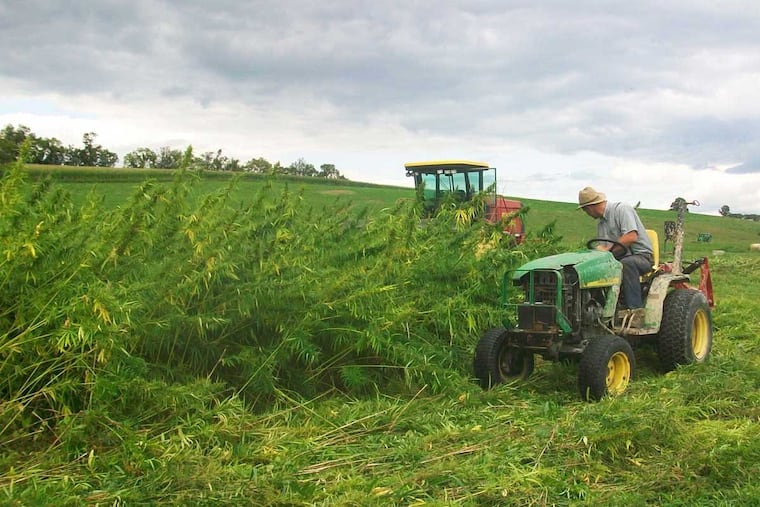Pa.'s once vast hemp harvest reemerges from the weeds
On 14 plots scattered across Pennsylvania this year, farmers reintroduced what was once a dominant cash crop to the state - industrial hemp, the straight-laced, non-psychoactive, cannabis cousin of marijuana.

On 14 plots scattered across Pennsylvania this year, farmers reintroduced what was once a dominant cash crop to the state: industrial hemp, the straight-laced, non-psychoactive cannabis cousin of marijuana.
Not one of the growers had any prior experience cultivating the plant, which grows so quickly that it's nicknamed "weed." So some problems were to be expected. However, nobody anticipated one complication.
"We had some projects that really did everything right, but were completely overrun by weeds" — real weeds, said Russell Redding, the state's secretary of agriculture. "You'd have fields that were beautifully green, but overwhelmed by unwanted species."
Sometimes knowledge is hard-won, even in a state with a long history of cultivation dating back to the colonial era and more than a dozen school districts named "Hempfield."
"It's a new old crop, a native crop, but we have a complete void of experience that we desperately need," said Redding, who is aiming to visit all 14 hemp plots that the state has permitted. "That's what this three-year project is about. We're working hard to build the groundwork."
Each of the experiments was viewed as a success, however. For starters, the crops grew faster than anyone expected, despite a delay in planting caused by the DEA holding up the seeds, which had to be imported from Canada.
"Everyone was blown away by how vigorous the plant is," said Ross Duffield, farm manager at the Rodale Institute's experimental farm near Kutztown. "It was the ugliest field of cannabis you ever saw, full of seeds and inconsistent growth. But in two months, we had 14 feet. It was heavy."
Rodale, ironically, planted hemp for a weed-suppression trial. Duffield said it did "a great job" smothering unwanted growth.
"We're hoping to build on that and grow a cash crop next year," he said.
Industrial hemp was banned along with marijuana in 1937 by the federal government partly because the two varietals of cannabis were easily confused with each other. Now hemp, like its skunky cousin, is resurgent.
At the same time marijuana is being pitched as a medicine of last resort, industrial hemp is being hailed as a wonder crop of another sort — its fiber for fabric and construction materials, its seeds for high-protein dietary supplements and a source of food-grade oil, and the whole plant as a source for CBD compounds which may have several valuable medical applications.
Commercial marijuana typically contains about 18 percent THC, the psychoactive compound that delivers a mind-bending wallop. Some varieties sold in Colorado contain up to 30 percent. Industrial hemp, on the other hand, contains a minuscule amount.
"It's absolutely useless as a drug crop," said Erica McBride, of the Pennsylvania Hemp Industry Council. Under Pennsylvania regulations, any hemp with a THC concentration greater than 0.3 percent must be destroyed.
The U.S. Drug Enforcement Administration still considers both varieties of cannabis — marijuana and hemp — as Schedule 1 substances, that is, with a high potential for abuse and no current medically accepted use. That hasn't stopped more than 30 states and the District of Columbia from broadly legalizing marijuana in some form. The Pennsylvania Department of Health expects medical marijuana products to be available to patients in early 2018.
More than 30 states have legislation authorizing pilot research programs for hemp, allowed under a research provision tucked into a federal farm bill, according to Geoffrey W. Whaling, chairman of the National Hemp Association.
Early this week, the hemp was as high as an elephant's eye on a five-acre field owned by Lehigh University, near Bethlehem. As bees buzzed around a hive tended by a former police officer, some scraggly stalks of hemp towered at more than 15 feet, Whaling said.
On Saturday, a small tractor outfitted with a sickle bar will reap the grassy harvest which was cultivated and monitored by the Pennsylvania Hemp Industry Council (PAHIC).
"It'll be like mowing a lawn," said McBride, the project's manager. "It'll take less than an hour." Hemp has a distinctly different look from marijuana, she said. "You want marijuana to be short and bushier to produce more flower, hemp is one major stalk that you want to have only one main cola, the flower that produces the seed."
The PAHIC project has three aims. One is investigating the Anka variety's ability to draw toxic substances and heavy metals out of the soil. Another is examining hemp's anti-microbial properties. The last is looking at possible applications of hemp fiber to be incorporated into dot-matrix nanosheet technology.
"Hemp has some of the same properties as copper," said Whaling, who jokingly calls himself Mr. Hemp and an Emperor of the Hempire. "There are people looking at developing electric batteries with it. We can do astounding things with hemp."
After the hemp is cut, it will lay on the fields for two weeks for "dew retting," a process that softens the fibers. The stalks later will be bound into tepee-like shocks to dry for use by Lehigh University researchers. "We had hoped to take some to make witches' brooms for Halloween," McBride said. "But we were shot down by the Department of Agriculture."
Next year, the state likely will allow growers to plant more than five acres, said Redding, the state's agriculture secretary. More important, there will be a concerted effort to have hemp reclassified so that it isn't considered a dangerous drug by the federal government.
"If we can do that, we can commercialize hemp and it won't have to stay a research project," Redding said. "But it's going to literally take an act of Congress."